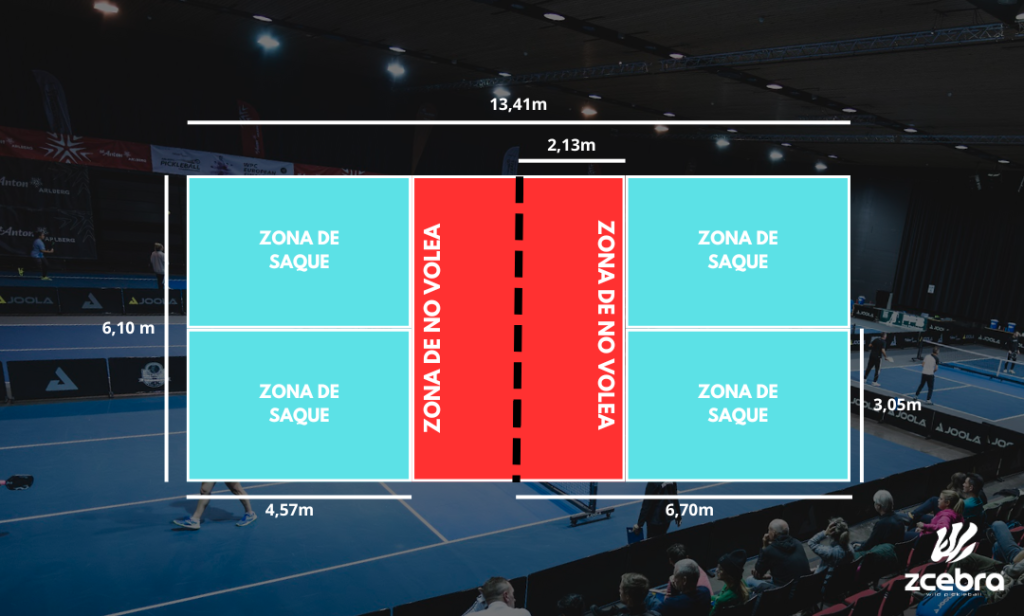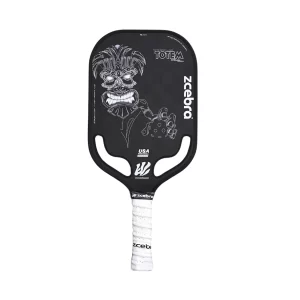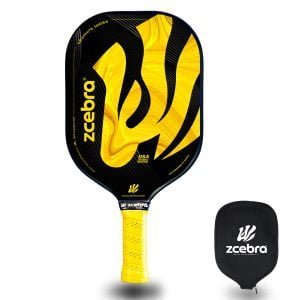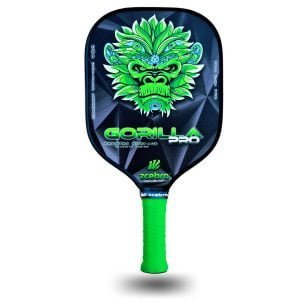Pickleball is a growing sport that requires a specific court with regulated dimensions and elements. The Pickleball court has standard measurements that must be adhered to for both singles and doubles matches, including the height of the net and the court lines. This sport can be played on courts made from various materials and adapted from other sports surfaces such as tennis or badminton. Knowing these measurements is essential for playing properly and safely. We tell you everything you need to know in this blog post.
History and Evolution of the Pickleball Court
The Pickleball court has its origins in the 1960s when Joel Pritchard, a U.S. congressman, along with his friend Bill Bell, devised a game that combined elements of different sports such as tennis, badminton, and ping-pong. Their intention was to create an activity that could be enjoyed by people of all ages and abilities, promoting fun and physical exercise.
- The name “Pickleball” originated from the Pritchard family’s dog, Pickles, who used to steal the balls during the early games.
- Over the years, Pickleball has experienced steady growth in popularity, especially in the United States, becoming a globally recognized sport.
- The Pickleball court has evolved to meet the needs of players, with specific rules and dimensions ensuring a fair and challenging game.
The Pickleball Court: Official Dimensions
Pickleball is a sport whose playing field has specific measurements that must be followed to ensure proper game development.
Standard Court Size
- Length: 13.41 meters
- Width: 6.10 meters for both singles and doubles play, divided in half by a centerline.
- Service Area. Length: 6.10 meters. Width: 3.05 meters, with a no-volley line 2.13 meters from the net.
- Service Area Dimensions: 6.10 meters long and 4.57 meters wide.

Differences with Other Sports Surfaces
The Pickleball court has unique dimensions and layout that distinguish it from other sports surfaces, tailored to the specific needs of the sport.
No-Volley Zone (The ‘Kitchen’)
The no-volley zone, also known as the ‘kitchen,’ is a key area on the Pickleball court that defines where players cannot perform volleys. Its correct definition and dimensions are fundamental to the game’s development.
Importance of the No-Volley Zone
The ‘kitchen’ on the Pickleball court helps maintain a strategic and balanced game by marking specific zones where certain rules must be followed.
Essential Elements of the Pickleball Court
To play Pickleball properly, it is essential to understand the key components of the Pickleball court. These components, such as the net, playing areas, and boundary lines, are crucial for understanding and enjoying this sport.
Net Details
Net Height: The standard net height on a Pickleball court is 91 cm at the sides and 86 cm in the center, ensuring fair and balanced play for all players.
Net Length: The total length of the Pickleball net is 6.7 meters, ensuring the ball stays in play properly and allowing players to make precise and effective shots during the match.
Net Posts and Materials
- Posts: The Pickleball net posts are made of high-strength polyethylene, ensuring their durability and stability during play. These posts are placed 6.7 meters apart, ensuring the net is correctly positioned and taut.
- Post Placement: The net posts are precisely and securely installed at the ends of the court, maintaining the net at the proper height and tension for optimal play.
Recommended Materials
It is recommended to use posts made of high-quality polyethylene or stainless steel, as they offer weather resistance and durability against ball impacts during play. Additionally, durable materials should be selected for the net itself, ensuring it can withstand continuous use and environmental conditions, such as nylon.
Lines and Markings on the Pickleball Court
- Baseline: Delimits the playing area in the longitudinal direction, marking the boundary of the court.
- Sidelines: These lines define the width of the court and determine whether a ball is in or out of bounds.
- Centerline: Divides the court into two equal halves, crucial for player positioning during the game.
Sidelines and Baselines
The sidelines and baselines are fundamental on the Pickleball court, marking the boundaries of the playing area. They have a specific width to ensure precision and fairness in the game’s development.
Line Width
- The sidelines and baselines have a standard width to clearly delineate the playing area.
Positioning and Function
- The sidelines and baselines are located at the edges of the court and define the valid playing area.
- Their function is to ensure that players respect the boundaries during the match.
Centerline and Service Areas
The centerline and service areas are essential elements for Pickleball play, contributing to the game’s strategy and dynamics. Their design and position play a crucial role in player distribution and the development of plays.
Division of Service Areas
- The centerline divides the court into two service areas, one on the right and one on the left, according to player rotation.
Basic Serving Rules
- The service areas mark the area from which the serve is made, requiring the player to serve within that area for it to be valid.
- Proper positioning in the service areas is crucial to start the point correctly and comply with the game rules.
Construction and Surfaces of the Pickleball Court
When it comes to constructing a Pickleball court, it is essential to consider the appropriate materials for the surface. Below are the most common options and recommendations for each:
Recommended Surface Materials
- Asphalt and Concrete: Asphalt and concrete are durable and popular materials for constructing Pickleball courts. Both offer a stable and resistant surface, ideal for consistent play.
- Rubber and Other Alternatives: Rubber is an alternative that has gained popularity in Pickleball court construction. This material provides a softer surface with better impact absorption, reducing the risk of injuries.
Climatic and Geographic Factors
It is crucial to consider climatic and geographic factors when planning the construction of a Pickleball court. Adaptation to different climates and geographical locations can influence the choice of materials and the court’s design. Environmental conditions must be considered to ensure the durability and optimal performance of the playing surface.
Design and Planning
- Total Space Dimensions: Before starting construction, it is essential to consider the total space dimensions available. The Pickleball court must fit adequately within the designated area, ensuring fair and balanced play.
- Lighting Considerations: Lighting is an essential aspect of Pickleball court design, especially if play is planned during low natural light hours. Proper lighting ensures adequate visibility and a safe environment for players.
Superficies de las pistas de Pickleball
En el Pickleball, las superficies de las pistas juegan un papel crucial en la experiencia de juego. A continuación, se detallan los diferentes tipos de superficies utilizadas en las pistas de Pickleball, sus ventajas y desventajas, así como consideraciones sobre el mantenimiento adecuado de la superficie de juego.
Pickleball Court Surfaces
In Pickleball, the surfaces of the courts play a crucial role in the playing experience. Below are the different types of surfaces used in Pickleball courts, their advantages and disadvantages, as well as considerations for the proper maintenance of the playing surface.
Different Types of Surfaces
- Concrete: One of the most common surfaces on Pickleball courts, offering durability and resistance.
- Asphalt: Another popular option, providing a uniform and low-maintenance surface.
- Pressurized Plastic: An innovative surface that can adapt to different climatic conditions and offers good grip.
- Parquet: A softer surface that provides a unique playing feel but requires specific maintenance.
Advantages and Disadvantages of Each Type of Surface
Each type of surface has its own advantages and disadvantages. For example, concrete is durable but can be hard on the joints, while parquet offers a pleasant feel but requires more care. It is important to consider the needs and preferences of the players when choosing the appropriate surface for a Pickleball court.
Maintenance of the Playing Surface
Regardless of the chosen surface, proper maintenance is essential to ensure safe and optimal play. It is important to perform cleaning tasks, repair cracks, and ensure the surface is level and in optimal condition to avoid injuries and prolong the life of the Pickleball court.
Adaptation of Other Courts to Play Pickleball
Pickleball is a versatile sport that can adapt to different types of pre-existing sports courts. Converting tennis courts to Pickleball courts is a common practice, as both disciplines share similarities in dimensions and layout. Additionally, adjustments can be made to ensure the new court meets Pickleball’s regulatory measurements.
Conversions of Tennis Courts to Pickleball
- Rules to Follow in the Adaptation: It is essential to follow the established regulations for the construction of Pickleball courts, ensuring that the dimensions and specific details of the field are respected.
- Necessary Changes in Dimensions and Markings: Adapting a tennis court to a Pickleball court requires adjustments in the lines and dimensions of the court to meet the appropriate standards.
Adaptation of Badminton Courts
- Adjustments to Meet Regulatory Measurements: When converting badminton courts to Pickleball courts, it is important to make modifications to ensure that the new court meets Pickleball’s specific dimensions and requirements.
Use of Multifunctional Courts
Multifunctional sports courts offer the possibility of adapting to different disciplines, including Pickleball. These versatile facilities allow space sharing among various sports modalities, promoting the practice of multiple activities in the same location.
Discover the Best Pickleball Paddles on the Market
-
 GORILLA PRO SERIES (Black) – Pure Carbon Pickleball Paddle105,99 €
GORILLA PRO SERIES (Black) – Pure Carbon Pickleball Paddle105,99 € -
 Pickleball paddle TOTEM Black Stream Series150,00 €
Pickleball paddle TOTEM Black Stream Series150,00 € -
 Pickleball Paddle GRAPHITE SERIES (yellow)69,99 €
Pickleball Paddle GRAPHITE SERIES (yellow)69,99 € -
 Pickleball paddle GRAPHITE SERIES (pink edition)69,99 €
Pickleball paddle GRAPHITE SERIES (pink edition)69,99 € -
 Carbon pickleball paddle GORILLA PRO SERIES (green)101,99 €
Carbon pickleball paddle GORILLA PRO SERIES (green)101,99 € -
 Carbon pickleball paddle GORILLA PRO SERIES (orange)101,99 €
Carbon pickleball paddle GORILLA PRO SERIES (orange)101,99 € -
 Pickleball paddle Carbon GORILLA PRO SERIES (Rainbow)101,99 €
Pickleball paddle Carbon GORILLA PRO SERIES (Rainbow)101,99 €
Basic Pickleball Rules Related to the Pickleball Court
Service Rules and Execution Area
The service in Pickleball is crucial to start the game correctly. The server must hit the ball below the waist and from behind the baseline, respecting the dimensions of the execution area.
Service Area and Its Delimitation
The service area extends from the centerline to the baseline, both on the right and left sides of the court. The serve must be made diagonally to the opposite court, always starting on the server’s right side.
Requirements for Executing the Service
The server cannot step on the service area line until the ball leaves their paddle. The serve must pass over the net and land in the diagonal box of the opposing court.
No-Volley Zone: Rules and Limitations
The no-volley zone, also known as the kitchen, is a key area in Pickleball that sets restrictions for hits made near the net. Volleys are not allowed within this area, and players must wait for the ball to bounce before hitting it.
Correct Use of the No-Volley Zone
Players must respect the no-volley zone to ensure fair and safe play. Entering this zone and hitting the ball without letting it bounce is prohibited.
Scoring and Rules Related to Boundaries
In Pickleball, points are scored when the opposing team fails to return the ball correctly or hits it out of bounds. The boundaries of the court play a crucial role in determining whether the ball is in or out of play.
Construction and Surfaces of the Pickleball Court
When constructing a Pickleball court, it’s essential to consider suitable materials for the surface. Here are the common options and recommendations:
Recommended Surface Materials
- Asphalt and Concrete: Durable and popular materials providing a stable and resilient surface.
- Rubber and Other Alternatives: Rubber offers a softer surface with better shock absorption, reducing injury risk.
Climatic and Geographic Factors
Considering climatic and geographic factors is crucial when planning a Pickleball court. Adapting to different climates and locations can influence the choice of materials and design, ensuring durability and optimal surface performance.
Design and Planning
- Total Space Dimensions: Consider the total available space before construction, ensuring the court fits appropriately and allows fair play.
- Lighting Considerations: Proper lighting is essential, especially for playing during low natural light conditions, ensuring adequate visibility and a safe environment for players.
Conversion of Other Courts for Pickleball
Pickleball is a versatile sport that can be adapted to various pre-existing sports courts. Converting tennis courts to Pickleball courts is common due to similarities in dimensions and layout. Additionally, adjustments can ensure the new court meets Pickleball’s regulatory measurements.
Conversion of Tennis Courts to Pickleball
- Rules for Adaptation: Follow the established regulations for Pickleball court construction, ensuring dimensions and specific details are respected.
- Necessary Changes in Dimensions and Markings: Adjust the lines and dimensions to meet Pickleball standards.
Basic Pickleball Rules Related to the Court
Serving Rules and Execution Area
The serve is crucial for starting the game correctly. The server must hit the ball below the waist from behind the baseline, within the designated area.
Service Zones and Boundaries
The service zone extends from the centerline to the baseline, both on the right and left sides of the court. The serve must be made diagonally to the opposite court, always starting on the server’s right side.
Requirements When Serving
The server cannot step on the service line until the ball leaves their paddle. The serve must go over the net and land in the diagonal court opposite.
Proper Maintenance of a Pickleball Court
Proper maintenance of a Pickleball court is essential for ensuring safe and optimal play conditions. Here are key aspects related to necessary adaptations and regular maintenance tasks:
Regular Maintenance
Periodic cleaning and conservation help preserve the court’s optimal condition and prolong its lifespan. Tasks include sweeping and cleaning the surface, inspecting, and repairing any damage to the net, posts, and lines.
Net and Anchor Maintenance
The Pickleball net is a key element that must be kept in optimal condition. Regularly check its tension and adjust it according to regulatory specifications. Inspect the net anchors to ensure firmness and stability.
Construction and Design of a New Pickleball Court
Constructing a Pickleball court is a process that requires attention to detail and the use of suitable materials. Each step, from initial planning to final implementation, is crucial for ensuring an optimal and safe playing space.
Recommended Materials and Technical Considerations
- Selecting the Right Color: The color of the court surface affects both aesthetics and ball visibility during play. Popular choices include green or light blue for their contrast with the Pickleball.
- Net Installation and Line Marking: The net must meet height and tension regulations. Line markings should be precise and clearly visible.
Companies Specializing in Pickleball Court Construction
Hiring specialized companies ensures high-quality and professional work. These companies have the experience and knowledge necessary for efficient project execution.
Approximate Costs and Financing Options
Construction costs vary depending on location, court size, and materials used. It is essential to request multiple quotes to compare and choose the best option. Various financing options are available, from government grants to local business financing agreements or community donations.
Key Considerations for Maintaining a Pickleball Court
Proper maintenance is essential for ensuring a safe and optimal playing experience. This includes regular cleaning, inspecting and repairing the net and anchors, and ensuring the lines and surface are in good condition.
Prevention of Damage to Different Surface Types
Different surface types require specific maintenance to prevent damage. For example, concrete surfaces need crack repair, while asphalt surfaces require sealing and preventive maintenance.
Basic Pickleball Game Rules
Fundamental Rules
Pickleball is played on a court with specific dimensions, using special paddles and a perforated ball. The objective is to outplay the opponent through skill, strategy, and coordination.
Key Playing Areas
- Service Zone: The back part of the court, divided by the centerline. Players must start the game by serving from this zone.
- No-Volley Zone: Known as “the kitchen,” it’s the area near the net where players cannot hit volleys.
Scoring and Match Format
Points are scored when the opposing team fails to return the ball correctly or hits it out of bounds. The game is played to 11 points, with the winning team needing at least a 2-point lead. Matches can be singles or doubles, affecting game dynamics and strategies.
Construction and Design of a Pickleball Court
When building a Pickleball court, several key considerations ensure its quality and functionality:
Space and Location
Choosing an appropriate location with enough space ensures the court fits correctly and allows for player movement.
Quality Materials for the Net and Posts
High-quality materials like polyethylene and stainless steel ensure durability and performance.
Environmental and Climate Factors
Consider environmental and climate factors to ensure the court’s durability and performance.
Basic Pickleball Game Rules
Pickleball Fundamentals
Pickleball is played on a specific court with regulatory dimensions, using special paddles and a perforated ball. The objective is to outplay the opponent through a combination of skill, strategy, and coordination.
Playing Zones and Areas
In pickleball, there are two key zones on the court: the service zone and the no-volley zone. These areas define where players can hit the ball with certain restrictions.
Service Zone
The service zone is the back part of the court, divided into two halves by the centerline.
Players must start the game by serving from this zone, hitting the ball over the net into the opposite diagonal square.
No-Volley Zone
Also known as “the kitchen,” this is the area of the court near the net where players cannot volley the ball.
Players must wait for the ball to bounce outside this zone before executing a volley shot.
Scoring and Match Format
Regarding scoring, pickleball is played to 11 points, but a team must win by at least 2 points. Matches can be either singles or doubles, which affects game dynamics and strategies.
Singles vs. Doubles Games
In singles games, each player faces their opponent one-on-one.
In doubles games, two players team up and compete against another team of two players.
Scoring System
To score a point, the team must win the opponent’s serve and score while holding the serve.
The scoring system ensures an equitable rotation of players and the possibility of a comeback in the score.
Volley and Serve Rules
The volley and serve rules are fundamental to the game’s development, establishing specific guidelines on how to perform these basic movements in pickleball.
No-Volley Rules (The Kitchen)
The no-volley rules, referring to the no-volley zone or “kitchen,” limit the shots players can make near the net.
These rules encourage strategic play and require players to use different tactics based on their position on the court.
Serve and Service Rules
The serve rules determine how each point begins and the serving sequence among players.
























